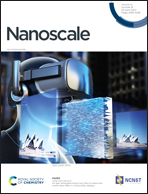Coupling amorphous cobalt hydroxide nanoflakes on Sr2Fe1.5Mo0.5O5+δ perovskite nanofibers to induce bifunctionality for water splitting†
Abstract
Developing cost-effective, stable and environmentally friendly catalysts is of prime importance for the commercial application of overall water splitting. Perovskite oxides have emerged as one of the promising bifunctional catalysts for the oxygen evolution reaction (OER) and hydrogen evolution reaction (HER). However, their bifunctional activity, especially towards HER, is still not meeting the anticipated energy efficiency. Herein, we highlight a facile and efficient surface modification approach for boosting the bifunctionality of perovskites for overall water splitting. The construction of amorphous cobalt hydroxide (Co(OH)2) on the Sr2Fe1.5Mo0.5O6−δ (SFM) surface is conducted via an atomic layer deposition (ALD) technology. The optimized crystalline core-amorphous shell structure only needs 384 mV to reach a current density of 10 mA cm−2 for the OER and 322 mV at −10 mA cm−2 for the HER in alkaline media. The optimized catalytic activity is probably due to the unique structure and the synergistic effect between Co(OH)2 and SFM, resulting in the large electrochemical surface area, abundant oxygen vacancies and fast electron transfer. The cell assembled with Co(OH)2/SFM-NF as both cathode and anode electrodes delivers a low voltage of 1.60 V to achieve 10 mA cm−2 and remarkable stability over 68 h in practical operation, offering a viable alternative for overall water splitting.



 Please wait while we load your content...
Please wait while we load your content...